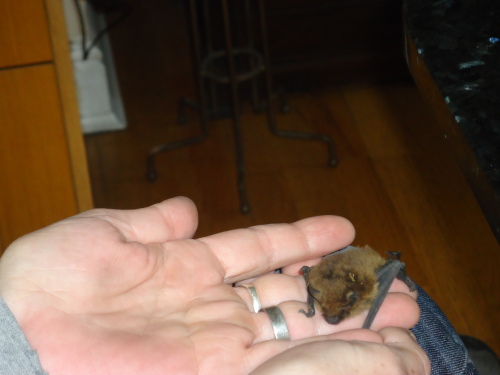 Last summer I nearly rode over this little bat. I picked it up and initially thought it was dead as it just lay in my hand freezing cold and not moving. Just as I was about to put it down, it stirred, so I took it home and called Jeff, usually referred to as the “Batman”. I’m ashamed to say that I had no idea how to care for a bat. When they come into the rescue they go straight off to the Batman who cares for about 100 at a time….and finances the whole operation out of his own money. The Batman couldn’t come out for the bat until the evening so I had to care for it for about eight hours. He told me to offer it water on a paint brush, feed it with mealworm then put it somewhere cool, like a garage. I found it strange having to put an ailing creature outdoors, normally the first thing we do in the rescue is put sickly or injured creature’s on a heat pad.
Last summer I nearly rode over this little bat. I picked it up and initially thought it was dead as it just lay in my hand freezing cold and not moving. Just as I was about to put it down, it stirred, so I took it home and called Jeff, usually referred to as the “Batman”. I’m ashamed to say that I had no idea how to care for a bat. When they come into the rescue they go straight off to the Batman who cares for about 100 at a time….and finances the whole operation out of his own money. The Batman couldn’t come out for the bat until the evening so I had to care for it for about eight hours. He told me to offer it water on a paint brush, feed it with mealworm then put it somewhere cool, like a garage. I found it strange having to put an ailing creature outdoors, normally the first thing we do in the rescue is put sickly or injured creature’s on a heat pad.
When the Batman arrived much to my relief, he gave me a crash course on bats and how to care for them.
It turned out I had myself a pipistrelle, the smallest of our 18 species of bats, weighing in at 5g. The largest British bat, the noctule, will still fit on the palm of a small hand. The reason I had to keep the bat cool was because during daytime, while roosting, bats allow their body temperature to drop close to that of their surroundings, slowing their metabolism to conserve energy. I think they are the only British mammal that can do this. It’s known as the daily torpor. Then at dusk, they warm their bodies and become active.
Young bats often ground themselves on their maiden flights so if you do see one out in the daylight, it’s usually in trouble. If you want to initially care for an injured bat, put it in a box lined with a towel that they can cling onto, then put it somewhere cool until it’s collected.
The numbers of bats have declined in Britain and all bats are now protected by law. It is illegal to intentionally kill, injure or possess a bat, but they can be kept and treated for release, but records must be kept as to where they were found and why they are in captivity. The major treats to bats are building renovation, loss of feeding grounds and habitat, lightening, wind turbines and mobile phone masts which interfer with their radar.
Across the country there are bat walks people can go on, to find out more, contact your local bat consevation group. If you need advice re building renovation that may affect a bat colony, contact the SNCO[Statutory Nature Consevation Organisation]
If you find an injured bat, your local bat conservation group can be contacted via the Bat Conservation Group on 0845 1300 288.
Sadly, my little bat died…but I now know what to do if I find another, and I won’t be fooled if it feels cold and isn’t moving!

Such a shame the poor creature died.